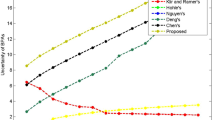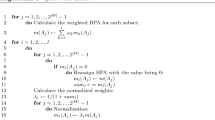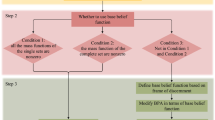Abstract
Conflicts in the evidence are addressed through various functions based on distance and similarity measure etc. Some complications and irrationality in existing distance measure is an open issue as how to address its conflicting degree. In this paper, we have introduced a new association coefficient measure primarily based on the modification of Jaccard’s similarity matrix with related properties and examples. In this paper, firstly the initial belief functions are constructed by using the fuzzy soft sets and information structure image matrix. Secondly, we used the proposed association coefficient measure to pre-process the initial belief function. Finally, Dempster’s combination rule is implemented to combine the modified belief function and rank the alternatives based on their final belief measure. The study is validated through various examples and a case study in medical diagnosis with the comparison of the existing two methods. The proposed association coefficient is efficient in representing the degree of association between the belief functions and modifying the belief function.






Similar content being viewed by others
References
Chen J, Fang Y, Jiang T, Tian Y (2017) Conflicting information fusion based on an improved DS combination method. Symmetry 9(11):278. https://doi.org/10.3390/sym9110278
Chen L, Diao L, Sang J (2018) Weighted evidence combination rule based on evidence distance and uncertainty measure: an application in fault diagnosis. Math Prob Eng. https://doi.org/10.1155/2018/58582722
Chen L, Diao L, Sang J (2019) A novel weighted evidence combination rule based on improved entropy function with a diagnosis application. Int J Distrib Sens Netw. https://doi.org/10.1177/1550147718823990
Cheng C, **ao F (2019) A new distance measure of belief function in evidence theory. IEEE Access 7:68607–68617. https://doi.org/10.1109/ACCESS.2019.2917630
Dempster A (1967) Upper and lower probabilities induced by a multi-valued map**. Ann Math Stat 38(2):325–339. https://doi.org/10.1214/aoms/1177698950
Deng Y, Shi W, Zhu Z, Liu Q (2004) Combining belief functions based on distance of evidence. Decis Supp Syst 38(3):489–493. https://doi.org/10.1016/j.dss.2004.04.015
Deng Z, Wang J (2020) A novel evidence conflict measurement for multi-sensor data fusion based on the evidence distance and evidence angle. Sensors 20(2):381. https://doi.org/10.3390/s20020381
Dong Y, Zhang J, Li Z, Hu Y, Deng Y (2019) Combination of evidential sensor reports with distance function and belief entropy in fault diagnosis. Int J Comput Commun Contr 14(3):329–343. http://univagora.ro/jour/index.php/ijccc/article/view/3589
Dubois D, Prade H (1986) A set theoretic view on belief functions: logical operations and approximations by fuzzy sets. Int J Gen Syst 12(3):193–226. https://doi.org/10.1080/03081078608934937
Han D, Deng Y, Han C (2011) Weighted evidence combination based on distance of evidence and uncertainty measure. J Inf Milli Waves 30(5):396–468. https://doi.org/10.1155/2018/5858272
Inagaki T (1991) Interdependence between safety control policy and multiple sensor schemes via Dempster–Shafer theory. IEEE Trans Reliab 40(2):182–188. https://doi.org/10.1109/24.87125
Jiang W (2018) A correlation coefficient for belief functions. Int J Approx Reason 103:94–106. https://doi.org/10.1016/j.ijar.2018.09.001
Jiang W, Huang C, Deng X (2019) A new probability transformation method based on a correlation coefficient of belief functions. Int J Intell Syst 34:1337–1347. https://doi.org/10.1002/int.22098
Jiang W, Wei B, **e C (2016) An evidential sensor fusion method in fault diagnosis. Adv Mech Eng 8(3):1–7. https://doi.org/10.1177/1687814016641820
Jiang W, Zhuang M, Qin X, Tang Y (2016) Conflicting evidence combination based on uncertainty measure and distance of evidence. Springerplus 5:1217. https://doi.org/10.1186/s40064-016-2863-4
Jones R, Lowe A, Harrison M (2002) A framework for intelligent medical diagnosis using the theory of evidence. Know Based Syst 15(1–2):77–84. https://doi.org/10.1016/S0950-7051(01)00123-X
Jousselme A, Grenier D, Bosse E (2001) A new distance between two bodies of evidence. Inf Fusion 2(2):91–101. https://doi.org/10.1016/S1566-2535(01)00026-4
Jousselme A, Maupin P (2012) Distances in evidence theory: comprehensive survey and generalizations. Int J Approx Reason 53(2):118–145. https://doi.org/10.1016/j.ijar.2011.07.006
Khalaj F, Khalaj M (2020) Developed cosine similarity measure on belief function theory: an application in medical diagnosis. Commun Stat Theory Methods. https://doi.org/10.1080/03610926.2020.1782935
Khalaj M, Khalaj F (2021) An improvement decision-making method by similarity and belief function theory. Commun Stat Theory Methods. https://doi.org/10.1080/03610926.2021.1949472
Li J, **e B, ** Y, Hu Z, Zhou L (2020) Weighted conflict evidence combination method based on Hellinger distance and the belief entropy. IEEE Access 8:225507–225521. https://doi.org/10.1109/ACCESS.2020.3044605
Li Z, Wen G, **e N (2015) An approach to fuzzy soft sets in decision making based on grey relational analysis and Dempster–Shafer theory of evidence: an application in medical diagnosis. Artif Intell Med 64:161–171. https://doi.org/10.1016/j.artmed.2015.05.002
Maji P, Biswas R, Roy A (2001) Fuzzy soft set. J Fuzzy Math 9(3):589–602
Maseleno A, Hasan M (2011) Avian influenza (H5N1) expert system using Dempster– Shafer theory. Int J Inf Commun Technol 4:227–324
Maseleno A, Hasan M (2012) Skin diseases expert system using Dempster–Shafer theory. Int J Intell Syst Appl 4(5):38–44. https://doi.org/10.5815/ijisa.2012.05.06
Maseleno A, Hasan M (2013) The Dempster–Shafer theory algorithm and its application to insect diseases detection. Int J Adv Sci Technol 50:111–120
Molodtsov D (1999) Soft set theory—first results. Comput Math Appl 37(4–5):19–31. https://doi.org/10.1016/S0898-1221(99)00056-5
Murphy C (2000) Combining belief functions when evidence conflicts. Decis Support Syst 29(1):1–9. https://doi.org/10.1016/S0167-9236(99)00084-6
Pan L, Deng Y (2019) An association coefficient of a belief function and its application in a target recognition system. Int J Intell Syst 35:85–104. https://doi.org/10.1002/int.22200
Shafer G (1976) A mathematical theory of evidence. Princeton University Press, Princeton
Smets P (2000) Data fusion in the transferable belief model. In: Proceedings of the third international conference on information fusion, vol 1, pp PS21–PS33. https://doi.org/10.1109/IFIC.2000.862713
Sun L, Chang Y, Pu J, Yu H, Yang Z (2020) A weighted evidence combination method based on the pignistic probability distance and Deng entropy. J Aerosp Tecnol Manag 12:e3320. https://doi.org/10.5028/jatm.v12.1173
Wang J, Hu Y, **ao F (2016) A novel method to use fuzzy soft sets in decision making based on ambiguity measure and Dempster–Shafer theory of evidence: an application in medical diagnosis. Artif Intell Med 69:1–11. https://doi.org/10.1016/j.artmed.2016.04.004
Wang J, Kuoyuan Q, Zhang Z, **ang F (2017) A new conflict management method in Dempster–Shafer theory. Int J Distrib Sens. https://doi.org/10.1177/1550147717696506
Wang J, **ao F, Deng X (2016) Weighted evidence combination based on distance of evidence and entropy function. Int J Distrib Sens Netw 12(7):3218784. https://doi.org/10.1177/1550147717696506
Wang P, Wang X (2008) Diagnosis method for cardiac patient based on improved Dempster–Shafer evidence theory. In: 2nd international conference on bioinformatics and biomedical engineering, pp 1935–1938
**ao F (2018) A hybrid fuzzy soft sets decision making method in medical diagnosis. IEEE Access 6:25300–25312. https://doi.org/10.1109/ACCESS.2018.2820099
**ao F (2018) An improved method for combining conflicting evidences based on the similarity measure and belief function entropy. Int J Fuzzy Syst 20:1256–1266. https://doi.org/10.1007/s40815-017-0436-5
**ao F, Qin B (2018) A weighted combination method for conflicting evidence in multi-sensor data fusion. Sensors 18(5):1487. https://doi.org/10.3390/s18051487
Yager R (1987) On the Dempster–Shafer framework and new combination rules. Inf Sci 41(2):93–137. https://doi.org/10.1016/0020-0255(87)90007-7
Zadeh L (1986) A simple view of the Dempster Shafer theory of evidence and its implication for rule of combination. AI Mag 7(2):85–90. https://doi.org/10.1142/9789814261302_0033
Zhang L (1994) Representation, independence, and combination of evidence in the Dempster–Shafer theory. Advances in the Dempster–Shafer theory of evidence. Wiley, New York, pp 51–69
Zhou Q, Mo H, Deng Y (2020) A new divergence measure of Pythagorean fuzzy sets based on belief function and its application in medical diagnosis. Mathematics 8(1):142. https://doi.org/10.3390/math8010142
Zhu C, **ao F (2021) A belief Hellinger distance for D–S evidence theory and its application in pattern recognition. Eng Appl Artif Intell. https://doi.org/10.1016/j.engappai.2021.104452
Zhu J, Wang X, Song Y (2018) A new distance between BPAs based on the power-set-distribution pignistic probability function. Appl Intell 48:1506–1518. https://doi.org/10.1007/s10489-017-1018-9
Author information
Authors and Affiliations
Corresponding author
Rights and permissions
About this article
Cite this article
Dutta, P., Limboo, B. A new association coefficient measure for the conflict management and its application in medical diagnosis. Int. j. inf. tecnol. 14, 3767–3779 (2022). https://doi.org/10.1007/s41870-022-01000-0
Received:
Accepted:
Published:
Issue Date:
DOI: https://doi.org/10.1007/s41870-022-01000-0




